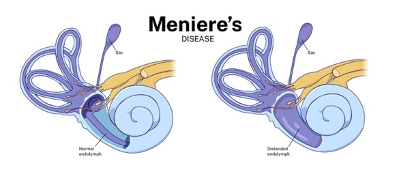We offer a specialised test battery in addition to our standard assessment if Menière’s disease is suspected. This includes:
- caloric testing to assess for hypofunction in the symptomatic ear
- extra-tympanic electrocochleography to assess for increased endolymphatic pressure in the symptomatic ear
- repeat audiometry (if required) to document any fluctuations in hearing
- Air-conduction cVEMP testing at 1kHz to assess for an enhanced response compared to the 500Hz stimulus
Caloric Testing
Research demonstrates that caloric testing is a valuable diagnostic tool for Ménière’s disease. While both caloric testing and the video head impulse test (vHIT) assess the function of the horizontal semicircular canals, they provide complementary insights. Specifically, asymmetric caloric responses coupled with normal vHIT results are most commonly linked to Ménière’s disease, serving as a potential diagnostic marker.
Ménière’s disease is an inner ear disorder characterised by tinnitus, vertigo, and hearing loss. While the exact cause remains unclear, it is believed to stem from the accumulation of endolymphatic fluid in both the cochlea and vestibular organs.
Definite Ménière’s Disease
To be diagnosed with definite Ménière’s disease, the patient must meet the following criteria:
- Two or more episodes of rotatory vertigo lasting 20 minutes to 12 hours.
- Low- to mid-frequency sensorineural hearing loss in the affected ear.
- Hearing loss must be documented and fluctuate, especially during or after an episode of vertigo.
- Tinnitus in the affected ear.
- Sensation of fullness in the affected ear.
References:
Hannigan, I. P., Welgampola, M. S., & Watson, S. R. D. (2021). Dissociation of caloric and head impulse tests: a marker of Meniere’s disease. Journal of Neurology, 268(2), 431–439. https://doi.org/10.1007/s00415-019-09431-9
Koenen, L., & Andaloro, C. (2023). Meniere Disease. In StatPearls. StatPearls Publishing.
Molnár, A., Maihoub, S., Tamás, L., & Szirmai, Á. (2023). Comparison between caloric and video-head impulse tests in Ménière’s disease and vestibular neuritis. International Journal of Audiology, 62(5), 393–399. https://doi.org/10.1080/14992027.2022.2059711
Murphy, K. A., & Anilkumar, A. C. (2023). Caloric Testing. In StatPearls. StatPearls Publishing.
Lopez-Escamez, J. A., Carey, J., Chung, W. H., Goebel, J. A., Magnusson, M., Mandalà, M., Newman-Toker, D. E., Strupp, M., Suzuki, M., Trabalzini, F., & Bisdorff, A. (2017). M. Menière: Diagnostische Kriterien des Internationalen Klassifikationskomitees der Bárány-Gesellschaft [Diagnostic criteria for Menière’s disease according to the Classification Committee of the Bárány Society]. HNO, 65(11), 887–893. https://doi.org/10.1007/s00106-017-0387-z
Oliveira, L. N. R., Oliveira, C. L. A., Lopes, K. C., & Ganança, F. F. (2021). Diagnostic assessment of patients with Meniere’s disease through caloric testing and the video-head-impulse test. Brazilian Journal of Otorhinolaryngology, 87(4), 428–433. https://doi.org/10.1016/j.bjorl.2019.10.008
Pappas, D. G., Jr, Pappas, D. G., Sr, Carmichael, L., Hyatt, D. P., & Toohey, L. M. (2000). Extratympanic electrocochleography: diagnostic and predictive value. The American Journal of Otology, 21(1), 81–87. https://doi.org/10.1016/s0196-0709(00)80079-4
Yilmaz, M. S., Egilmez, O. K., Kara, A., Guven, M., Demir, D., & Genc Elden, S. (2021). Comparison of the results of caloric and video head impulse tests in patients with Meniere’s disease and vestibular migraine. European Archives of Oto-Rhino-Laryngology : Official Journal of the European Federation of Oto-Rhino-Laryngological Societies (EUFOS) : Affiliated with the German Society for Oto-Rhino-Laryngology – Head and Neck Surgery, 278(6), 1829–1834. https://doi.org/10.1007/s00405-020-06272-5

